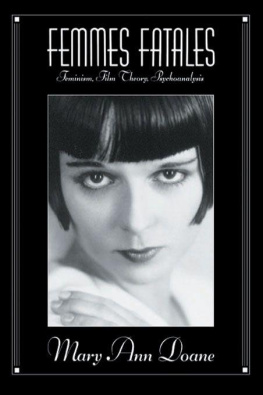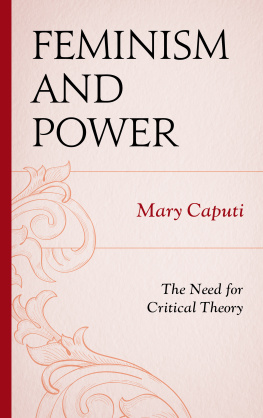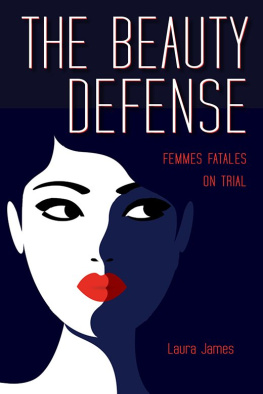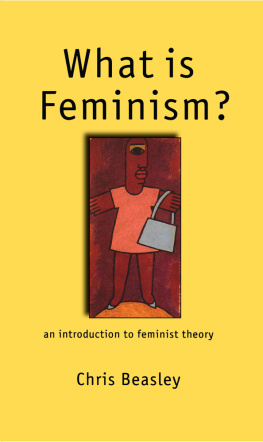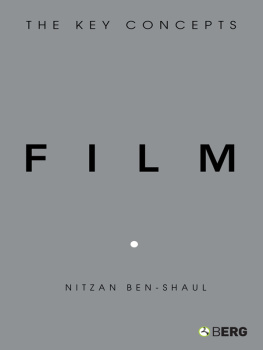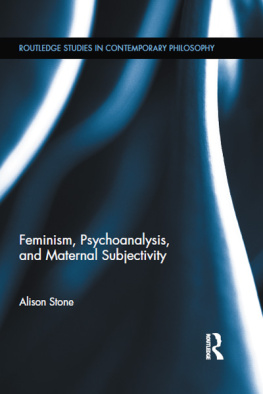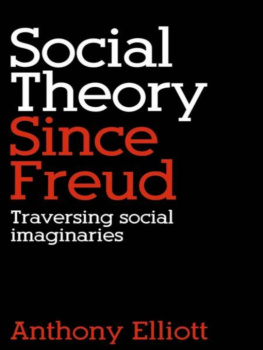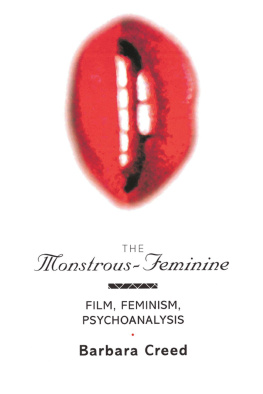Mary Ann Doane - Femmes Fatales: Feminism, Film Theory, Psychoanalysis
Here you can read online Mary Ann Doane - Femmes Fatales: Feminism, Film Theory, Psychoanalysis full text of the book (entire story) in english for free. Download pdf and epub, get meaning, cover and reviews about this ebook. year: 2013, publisher: Taylor and Francis, genre: Romance novel. Description of the work, (preface) as well as reviews are available. Best literature library LitArk.com created for fans of good reading and offers a wide selection of genres:
Romance novel
Science fiction
Adventure
Detective
Science
History
Home and family
Prose
Art
Politics
Computer
Non-fiction
Religion
Business
Children
Humor
Choose a favorite category and find really read worthwhile books. Enjoy immersion in the world of imagination, feel the emotions of the characters or learn something new for yourself, make an fascinating discovery.
- Book:Femmes Fatales: Feminism, Film Theory, Psychoanalysis
- Author:
- Publisher:Taylor and Francis
- Genre:
- Year:2013
- Rating:3 / 5
- Favourites:Add to favourites
- Your mark:
- 60
- 1
- 2
- 3
- 4
- 5
Femmes Fatales: Feminism, Film Theory, Psychoanalysis: summary, description and annotation
We offer to read an annotation, description, summary or preface (depends on what the author of the book "Femmes Fatales: Feminism, Film Theory, Psychoanalysis" wrote himself). If you haven't found the necessary information about the book — write in the comments, we will try to find it.
Femmes Fatales: Feminism, Film Theory, Psychoanalysis — read online for free the complete book (whole text) full work
Below is the text of the book, divided by pages. System saving the place of the last page read, allows you to conveniently read the book "Femmes Fatales: Feminism, Film Theory, Psychoanalysis" online for free, without having to search again every time where you left off. Put a bookmark, and you can go to the page where you finished reading at any time.
Font size:
Interval:
Bookmark:
FEMMES FATALES
FEMMES FATALES
Feminism, Film Theory, Psychoanalysis
Mary Ann Doane

For Bob and Jo Ann
Published in 1991 by
Routledge
270 Madison Ave,
New York NY 10016
Published in Great Britain by
Routledge
2 Park Square, Milton Park,
Abingdon, Oxon, OX14 4RN
Routledge is an imprint of the Taylor & Francis Group, an informa business
Transferred to Digital Printing 2008
Copyright 1991 by Routledge
All rights reserved. No part of this book may be reprinted or reproduced or utilized in any form or by any electronic, mechanical or other means, now known or hereafter invented, including photocopying and recording, or in any information storage or retrieval system, without permission in writing from the publishers.
Library of Congress Cataloging in Publication Data
Doane, Mary Ann.
Femmes fatales : feminism, film theory, and psychoanalysis / Mary Ann Doane.
p. cm.
Includes bibliographical references and index.
1. Femmes fatales in motion pictures. 2. Sex in motion pictures. 3. Feminism and motion pictures. I. Title.
PN1995.9F44D6 1991
791.43652042dc20 91-3659
British Library Cataloguing in Publication data also available
ISBN 10: 0-415-90319-X (hbk)
ISBN 10: 0-415-90320-3 (pbk)
ISBN 13: 978-0-415-90319-6 (hbk)
ISBN 13: 978-0-415-90320-2 (pbk)
Publishers Note
The publisher has gone to great lengths to ensure the quality of this reprint but points out that some imperfections in the original may be apparent.
Table of Contents
Acknowledgments
This book was written over a number of years and many people have offered valuable criticism, support, and encouragement. Because much of my writing derives from my teaching, I would first like to thank my students at Brown University and The University of Iowa for their sustained curiosity and brilliance, which proved to be contagious. I would also like to thank those who contributed quite materially to the production of these essays by organizing the conferences where they were first presented. Those colleagues who gave particularly helpful advice on certain sections of the book are thanked individually at the beginning of the footnote section of these essays. Peggy Phelan and Linda Williams read an early version of the manuscript and I took their rigorous criticisms (as well as their strong encouragement) very much to heart, although I may not have been entirely adequate to resolving the problems they so astutely pinpointed. The members of a feminist reading group at BrownChristina Crosby, Copplia Kahn, Karen Newman, and Ellen Rooneyread and intensively interrogated a number of the essays. Leora Tannenbaum, Ruth Santos, and Virginia Polselli gave crucial support in the preparation of the manuscript. I would especially like to thank Joan Copjec, Naomi Schor, and Elizabeth Weed for sharing with me their knowledge, skills, and dedication to feminist theory. Finally, special thanks go to Phil Rosen for offering clarity, sanity, and lucidity when it was most needed.
A number of the essays included here have been published elsewhere, in earlier versions, in the following journals and anthologies:
Film and the Masquerade: Theorising the Female Spectator, Screen 23.34 (1982), by permission of Oxford University Press and the John Logie Baird Centre.
Masquerade Reconsidered: Further Thoughts on the Female Spectator, Discourse 11.1 (198889).
Veiling Over Desire: Close-ups of the Woman, Feminism and Psychoanalysis, ed. Richard Feldstein and Judith Roof. Copyright (c) 1989 by Cornell University. Reprinted with permission of Cornell University Press.
Remembering Women: Psychical and Historical Constructions in Film Theory, Psychoanalysis and Cinema, ed. E. Ann Kaplan (New York: Routledge, 1990).
Gilda: Epistemology as Striptease, Camera Obscura 11 (Fall 1983).
The Abstraction of a Lady: La Signora di tutti, Cinema Journal 28.1 (1988), copyright (c) 1988 by the Board of Trustees of the University of Illinois.
The Erotic Barter: Pandoras Box (1929), The Films of G. W. Pabst: An Extraterritorial Cinema, ed. Eric Rentschler. Copyright (c) 1990 by Rutgers, The State University. Reprinted with permission of Rutgers University Press.
Womans Stake: Filming the Female Body, October 17 (Summer 1981).
The Retreat of Signs and the Failure of Words: Leslie Thorntons Adynata, Millenium Film Journal 16/17/18 (Fall/Winter 198687).
When the direction of the force acting on the body is changed: The Moving Image, Wide Angle 7.12 (1985).
I am grateful for permission to reprint these essays here.
INTRODUCTION
Deadly Women, Epistemology, and Film Theory
The femme fatale is the figure of a certain discursive unease, a potential epistemological trauma. For her most striking characteristic, perhaps, is the fact that she never really is what she seems to be. She harbors a threat which is not entirely legible, predictable, or manageable. In thus transforming the threat of the woman into a secret, something which must be aggressively revealed, unmasked, discovered, the figure is fully compatible with the epistemological drive of narrative, the hermeneutic structuration of the classical text. Sexuality becomes the site of questions about what can and cannot be known. This imbrication of knowledge and sexuality, of epistemophilia and scopophilia, has crucial implications for the representation of sexual difference in a variety of discoursesliterature, philosophy, psychoanalysis, the cinema. Both cinematic and theoretical claims to truth about women rely to a striking extent on judgments about vision and its stability or instability. Although her origins are literary and pictorial, the femme fatale has a special relevance in cinematic representation, particularly that of Hollywood insofar as it appeals to the visible as the ground of its production of truth.
The femme fatale emerges as a central figure in the nineteenth century, in the texts of writers such as Thophile Gautier and Charles Baudelaire and painters such as Gustave Moreau and Dante Gabriel Rossetti. If, as Christine Buci-Glucksmann points out, the archaeology of modernity is haunted by the feminine, the femme fatale is one of its most persistent incarnations. It is not surprising that the cinema, born under the mark of such a modernity as a technology of representation, should offer a hospitable home for the femme fatale. She persistently appears there in a number of reincarnations: the vamp of the Scandinavian and American silent cinemas, the diva of the Italian film, the femme fatale of film noir of the 1940s.
In what does the deadliness of the femme fatale consist and why is she so insistently a figure of fascination in the texts of modernity? Her power is of a peculiar sort insofar as it is usually not subject to her conscious will, hence appearing to blur the opposition between passivity and activity. She is an ambivalent figure because she is not the subject of power but its carrier (the connotations of disease are appropriate here). Indeed, if the femme fatale overrepresents the body it is because she is attributed with a body which is itself given agency independently of consciousness. In a sense, she has power despite herself. The evacuation of intention from her operations is fully consistent with the epistemological recognition accorded to the newly born psychoanalytic concept of the unconscious. The femme fatale is an articulation of fears surrounding the loss of stability and centrality of the self, the I, the ego. These anxieties appear quite explicitly in the process of her representation as castration anxiety. Virginia Allen has associated the femme fatale with that moment of abandonment in the sex act and the ensuing loss of self-awareness.male fears about feminism. Nevertheless, the representationlike any representationis not totally under the control of its producers and, once disseminated, comes to take on a life of its own.
Next pageFont size:
Interval:
Bookmark:
Similar books «Femmes Fatales: Feminism, Film Theory, Psychoanalysis»
Look at similar books to Femmes Fatales: Feminism, Film Theory, Psychoanalysis. We have selected literature similar in name and meaning in the hope of providing readers with more options to find new, interesting, not yet read works.
Discussion, reviews of the book Femmes Fatales: Feminism, Film Theory, Psychoanalysis and just readers' own opinions. Leave your comments, write what you think about the work, its meaning or the main characters. Specify what exactly you liked and what you didn't like, and why you think so.

